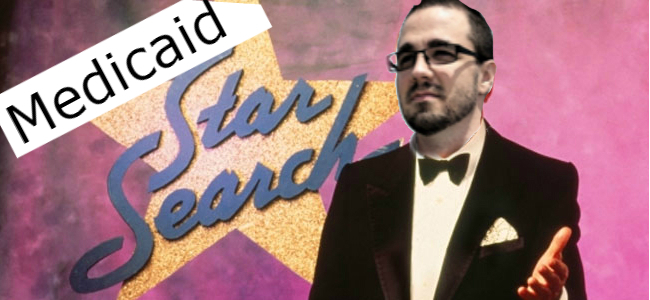
Want to find out about what innovative companies are doing in the Medicaid space, but don’t want to sit through boring demos? On this episode of Medicaid Star Search, we talked to netlogx, CipherHealth and TripSpark Technologies.

Want to find out about what innovative companies are doing in the Medicaid space, but don’t want to sit through boring demos? On this episode of Medicaid Star Search, we talked to netlogx, CipherHealth and TripSpark Technologies.

There are two slightly different versions of the federal poverty measure: poverty thresholds and poverty guidelines.
The poverty thresholds are the original version of the federal poverty measure. They are updated each year by the Census Bureau. The thresholds are used mainly for statistical purposes — for instance, preparing estimates of the number of Americans in poverty each year. (In other words, all official poverty population figures are calculated using the poverty thresholds, not the guidelines.) Poverty thresholds since 1973 (and for selected earlier years) and weighted average poverty thresholds since 1959 are available on the Census Bureau’s Web site. For an example of how the Census Bureau applies the thresholds to a family’s income to determine its poverty status, see “How the Census Bureau Measures Poverty” on the Census Bureau’s web site.
The poverty guidelines are the other version of the federal poverty measure. They are issued each year in the Federal Register by the Department of Health and Human Services (HHS). The guidelines are a simplification of the poverty thresholds for use for administrative purposes — for instance, determining financial eligibility for certain federal programs.
The poverty guidelines are sometimes loosely referred to as the “federal poverty level” (FPL), but that phrase is ambiguous and should be avoided, especially in situations (e.g., legislative or administrative) where precision is important. The January 2018 poverty guidelines are calculated by taking the 2016 Census Bureau’s poverty thresholds and adjusting them for price changes between 2016 and 2017 using the Consumer Price Index (CPI-U). The poverty thresholds used by the Census Bureau for statistical purposes are complex and are not composed of standardized increments between family sizes. Since many program officials prefer to use guidelines with uniform increments across family sizes, the poverty guidelines include rounding and standardizing adjustments in the formula.
Further reading –

Fully Integrated Dual Eligible (FIDE) SNPs were created by Congress in section 3205 of the Affordable Care Act (ACA). Designed to promote the full integration and coordination of Medicare and Medicare benefits for dual eligible beneficiaries by a single managed care organization, FIDE-SNPs are described in section 1853(a)(1)(B)(iv) of the Social Security Act and at 42 CFR §422.2.
FIDE SNPs must meet the following five elements:
Further reading –

Medicaid Who’s Who: Audrey Taylor – CEO and Founder of netlogx LLC
1. Which segment of the industry are you currently involved?
A: netlogx has a wide breadth and depth of experience in the Medicaid Industry with several specializations spanning both State governments and private sector healthcare entities. Our expertise includes:
2. How many years have you been in the Medicaid industry?
A: Since the inception of the company in 1998, netlogx has been operating in the health and human services practice area and has actively supported State Medicaid programs for all 20 years.
3. What is your focus/passion? (Industry related or not)
A: I am passionate about lifting up women to help them follow their dreams and meet their goals; especially those who own, or seek to own, their own businesses.
4. What is the top item on your “bucket list?”
A: At the netlogx corporate office we have a “Before I Die Wall” and I’ve added that I’d like travel to a destination of my choice with no prior planning.
5. What do you enjoy doing most with your personal time?
A: Reading is my favorite past time; I find it provides the opportunity to visit other cities, counties and periods of history all with the turn of a page.
6. Who is your favorite historical figure and why?
A: I find the lives of iconic women of history to be illuminating – as I read about Elizabeth I and her choice not to marry, I marvel at how she learned to navigate in a man’s world.
7. What is your favorite junk food?
A: As a former Brit turned American, I have two: Here in the U.S. it is a hamburger, ideally with blue cheese, lettuce, tomato and onion. Back in the U.K., it is fish and chips with a side of curry sauce!
8. Of what accomplishment are you most proud?
A: My family – my husband is my greatest champion and partner in both life and work and our sons are both a joy and a challenge. Since our sons are both adults now, it will be all joy from here on in!
9. For what one thing do you wish you could get a mulligan?
A: I feel that I learn more from my mistakes than from my successes, so I guess I’m going to skip the mulligan.
10. What are the top 1-3 issues that you think will be important in Medicaid during the next 6 months?
A:

The Family Health Insurance Assistance Program, or FHIAP, was created by the 1997 Oregon Legislature to help uninsured, income-eligible Oregonians afford private health insurance. The program pays from 50 percent to 95 percent of its members’ monthly premium for health insurance.
FHIAP does not help pay for deductibles, co-pays, or other coinsurance. FHIAP will assist clients in paying their premium either for individual insurance, or insurance through their employer (Group insurance). It is NOT an insurance plan. It does NOT pay for co-pays or deductibles.
It will subsidize dental for group insurance only.
The differences between FHIAP and Medicaid:
FHIAP is not an insurance plan; therefore, it does not pay for anything other than its portion of the premium.
With FHIAP, deductibles, co-pays, and other cost sharing items are paid by the client.
Medicaid pays it all.
Further reading –
http://library.state.or.us/repository/2008/200803131406124/index.pdf

Soundtrack for today’s RoundUp pessimist readers- http://bit.ly/2DveZ0w (what an amazing song, nay – album!)
For optimist readers- http://bit.ly/2DvfoQA
LET’S TALK SHOP AT MEDICAID INNOVATIONS 2018 – I will be in Florida again (7th year for me, I think) for the Medicaid Innovations Conference. If you are going, let’s plan on meeting up. Jan 31-Feb 2, 2018. Check it out here- http://bit.ly/2mbKtl1
WORKIN’ FOR THE WEEKEND- The big buzz this week was KY getting its Medicaid work requirements waiver approved by CMS. This will have big implications for the dozen or so other states waiting on approval for their own waivers. This is an important change for the Medicaid program, so let’s spend this week’s roundup considering perspectives on it.
FIRST THE FACTS, MAM – KY is the first state to get approval for a slew of “conservative” features to modify its Medicaid program. Features include a work requirement (that doesn’t apply to pregnant women, children, the elderly, the physically disabled or the developmentally disabled), bennies will pay premiums up to 4% of their income, and bennies can be locked-out of coverage if they don’t prove their eligibility as required / scheduled. For the work requirements (also called “community engagement”), bennies that must meet these have to put in 80 hours a month starting in July (giving them 6 months to find a part-time job if they want to keep their Medicaid benefits). Overall about 350,000 bennies have to meet this requirement, and about 175,000 of them already meet it. One last thing on the “work” requirement – under new CMS guidelines on the next-gen waivers, if a benny has an addiction, getting treatment can count towards your hours.
Now let’s look at some point / counter-point for each camp.
TALKING POINTS FROM THE “SKY IS FALLING/ REPUBLICANS ARE EVIL CREW”-
Counterpoints: Litigation (with or without a belief in its merit even by the plaintiff) is a proven method of resistance. One can just as easily argue that it makes the program more efficient and thus frees up more money to better meet the objectives of the program.
Counterpoints: Maybe. It could be very simple if states work with the right vendors. This is a whole new area for technology solution providers, and they could build off of existing systems like the unemployment data sets.
Counterpoints: Not really. States have made sure to target who this applies to so that those that cannot be expected to work are not under the requirement. But I am sure this attack will be repeated over and over anyway. Emotional (regardless of veracity) appeals work.
Counterpoints: Unproveable, but high value to throw out the bombastic claim (with no cost of making it)
Counterpoints: If they are that sick, then do they meet the disability requirements?
Counterpoints: What about the 50% of those under new requirements in KY that already are working? Or the study in JAMA showing about half of Medicaid bennies in Michigan working? This is just “making it official” for half of those impacted, and putting the other half on notice.
Counterpoints: So are all new ideas at first (especially in Medicaid). And most 1115 demo waivers remain demos forever and never really get evaluated anyway (see recent OIG criticism on this). If we slapped buzzwords like “population health” or “big data” on it, would you like it then? Or maybe a job could be one of those “social determinants of health”?
Counterpoints: Maybe. Or maybe DSH never really went away, and maybe uncompensated care costs are an unproven black box useful for strong-arm budget tactics.
POINTS FROM THE “THIS IS WHAT INNOVATION LOOKS LIKE EVEN IF YOU DISAGREE WITH IT CREW”-
Counterpoints: For the most part I agree. The tricky part is this is healthcare, and you have to think through how to deal with catastrophic coverage. And the idea that healthcare is a human right has gained a lot of ground in recent years.
Counterpoints: See above
Counterpoints: I also agree. I personally know several people who were homeless / near homeless and a job and the commitment to it changed their life. But- Making this work will require an overall strategy in your state tied to jobs / your local economy. You can’t just get this waiver approved and expect various issues to magically be resolved.
Counterpoints: Makes total sense. Now if we could also deal with all the cash lost to fraud. I have some ideas on that. Call me.
Counterpoints: Big Duh, here. Big question is where line is drawn investing limited dollars on those who won’t get engaged (at the cost of not spending it on those who will). Or just pretend there is unlimited dollars for Medicaid and all is fine and we can go back to the fairy tale of the way Medicaid was funded before Evil Trump came along.
Counterpoints: I think you can guess by now I agree with this one. Here, Hear!
WHAT’S NEXT – There’s a cue forming for these types of waivers. Last I looked it was 10 states — Arizona, Arkansas, Indiana, Kansas, Kentucky, Maine, New Hampshire, North Carolina, Utah and Wisconsin. Combine the KY approval with CMS guidance recently released, and we will watch most of these get approved before summer. And more will follow.
CMS head Veerma is not playing around. She continues describe opponents of these ideas as holding onto “the soft bigotry of low expectations.” Whether the general blogosphere / MSM will ignore that volley, or attack it directly (many do), I am not sure. But she is claiming moral high ground from a conservative vantage point. And to do that in Medicaid is perhaps unprecedented. Or at least its been so long since we’ve seen it maybe we don’t recognize it. It may just be that fiscal hawks have had enough of being bullied by the doves, and have found their voice in a lady named Seema.
That’s it for this week. As always, please send me a note with your thoughts to clay@mostlymedicaid.com or give me a buzz at 919.727.9231. Get outside (at least to put salt on your steps) and keep running the race (you know who you are).
FULL, FREE newsletter@ mostlymedicaid.com . News that didn’t make it and sources for those that did: twitter @mostlymedicaid . Trystero: Tėvas pasiuntė Sūnų išgelbėti pasaulį.

The Fraud Enforcement and Recovery Act of 2009, or FERA, Pub.L. 111–21, S. 386, 123 Stat. 1617, enacted May 20, 2009, is a public law in the United States enacted in 2009. The law enhanced criminal enforcement of federal fraud laws, especially regarding financial institutions, mortgage fraud, and securities fraud or commodities fraud.
Further reading –
https://en.wikipedia.org/wiki/Fraud_Enforcement_and_Recovery_Act_of_2009

Dual Eligible Special Needs Plans (D-SNPs) enroll beneficiaries who are entitled to both Medicare (Title XVIII) and Medical Assistance from a State Plan under Title XIX (Medicaid), and offer the opportunity of enhanced benefits by combining those available through Medicare and Medicaid.
Further reading –
https://www.cms.gov/Medicare/Health-Plans/SpecialNeedsPlans/DualEligibleSNP.html#s1

Disproportionate Share Hospitals serve a significantly disproportionate number of low-income patients and receive payments from the Centers for Medicaid and Medicare Services to cover the costs of providing care to uninsured patients. Disproportionate share hospitals are defined in Section 1886(d)(1)(B) of the Social Security Act.
To be eligible to participate in the 340B Drug Pricing Program, disproportionate share hospitals must meet the requirements of 42 USC 256b(a)(4)(L).
Further reading –

Cost-Sharing Reduction – A discount that lowers the amount you have to pay for deductibles, copayments, and coinsurance. In the Health Insurance Marketplace, cost-sharing reductions are often called “extra savings.” If you qualify, you must enroll in a plan in the Silver category to get the extra savings.
When you fill out a Marketplace application, you’ll find out if you qualify for premium tax credits and extra savings. You can use a premium tax credit for a plan in any metal category. But if you qualify for extra savings too, you’ll get those savings only if you pick a Silver plan.
If you qualify for cost-sharing reductions, you also have a lower out-of-pocket maximum — the total amount you’d have to pay for covered medical services per year. When you reach your out-of-pocket maximum, your insurance plan covers 100% of all covered services.
If you’re a member of a federally recognized tribe or an Alaska Native Claims Settlement Act (ANCSA) Corporation shareholder, you may qualify for additional cost-sharing reductions.
Further reading –